
Company Overview
Carmeuse Lime (Canada) Limited (Carmeuse) is an international, leading producer of high-quality lime, chemical grade limestone, and aggregate products with over 70 years of operating experience in Ontario. Limestone has been mined in Oxford County area since the mid-1800s and various limestone kilns have operated in this area since about that time. Carmeuse has operated the Beachville facility for more than 20 years. This facility is one of the largest employers in Oxford County, employing nearly 100 full-time workers. The Carmeuse Beachville facility is located at 374651 37th Line (Oxford County Road #6), Ingersoll, Ontario
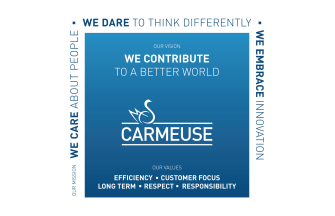
Lime is a product which has a wide range of uses including:
- Remediate water and flue-gas emissions
- Increase the strength of iron and steel, as well as in the production of glass, ceramic, and other building products
- Processing of pulp and paper and non-ferrous metal
- Variety of agricultural applications, and
- It can be further refined into laboratory-grade and food-grade qualities
At Carmeuse, we pride ourselves knowing that our products make steel stronger, air cleaner, water purer, and roadways last longer — a vital ingredient in the materials that build and renew infrastructure around the World.
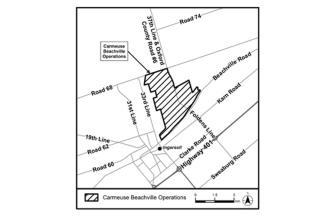
This facility is one of the largest employers in Oxford County, employing nearly 100 full-time workers.
Carbon Challenge
Carbon dioxide (CO2) is the primary Greenhouse Gas produced at Beachville, with greater than 95% being released from the kilns. More than 50% of the CO2 is produced through the chemical conversion of limestone into lime. The remaining CO2 emissions are from fossil fuel combustion. Greenhouse Gases such as CO2 contribute to climate change.
There are no feasible options for Carmeuse to reduce the process related CO2 emissions. Changing the type of fuel combusted is a viable opportunity to reduce CO2 emissions. The use of Alternative Low-Carbon Fuels instead of conventional fuels will:
- Reduce CO2 emissions from fuel combustion emissions
- Reduce other emissions, such as sulphur dioxide (SO2) and metals
- Provide a lower fuel cost and increase the fuel flexibility enabling Carmeuse to remain competitive with lime producers in the United States of America

Community Connections
The use of Alternative Low-Carbon Fuels is a sustainable way to use resources that would otherwise be landfilled, reducing the overall waste going to landfill or other means of disposal. Locally sourced fuels such as wood waste, agricultural waste, or crops grown for the purpose of being a fuel can create local jobs rather than importing fossil fuels.
Carmeuse is collaborating with local First Nations groups on a new biomass project to utilize wood fiber that cannot be sold. This project will connect suppliers in the forest industry to end-users and work to develop technology that converts underutilized wood into a fuel source. This project is supported by the Ministry of Natural Resources and Forestry and is aiming to be a sustainable answer to reducing fossil fuel use.
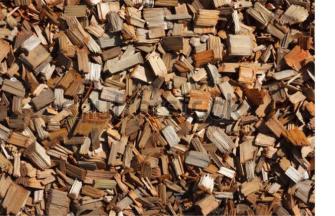
Proposed Full-Scale Use of Alternative Low-Carbon Fuels (ALCF)
Equipment
There are two main facility modifications necessary to combust ALCF at Carmeuse: a fuel handling system and modified kiln burners.
Dedicated enclosed storage of Alternative Low-Carbon Fuels is required in addition to an unloading, weighing, and feeding system. The fuel remains within the enclosed transport truck trailer and a moving conveyor floor in the trailer feeds the fuel into the unloading system.
The fuel is weighed to track the quantity being used. The fuel is then conveyed to the kiln for combustion.
The second modification is the use of multi-fuel kiln burners which allow for a variety of fuels to be introduced into the kiln, depending on the energy needs and available fuel supply. The use of multi-fuel burners enables seamless transition between fuels depending on production needs.
ALCF are anticipated to replace approximately 75% of coal by weight and 75% by energy content.
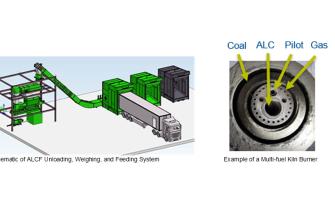
Proposed Alternative Low-Carbon Fuels
Carmeuse is proposing to utilize several types of ALCF depending on the available supply. One of the primary fuels will be an engineered ALCF. This is a fuel composed of a mixture of non-hazardous and non-recyclable material which is blended to meet the required energy content, biological carbon content, moisture content, etc. As seen in the photo, the fuel is comprised of multiple components blended into a homogenous mixture. Several tests are performed on the mixture to ensure it has the required energy content, as well as ensuring that undesirable components (e.g. sulphur and metals) are low
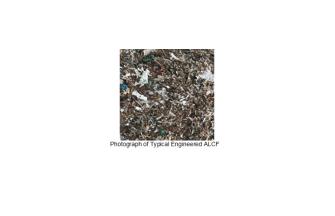
The engineered ALCF approved for the ALCF Demonstration Project and proposed for full-scale use is a mixture of:
- Non-recyclable packaging
- Paper by-product, also known as paper sludge
- Non-recyclable rubber and plastic
- Nylon obtained from tire fluff
- Unsalable consumer sanitary products (such as diapers) - these are new, unused products that cannot be sold to customers due to a manufacturing flaw
- Woodwaste
These materials would commonly be disposed of in a landfill. Using this material as a fuel reduces the carbon dioxide emissions and reduces the quantity of material being landfilled or otherwise disposed of.
Apart from the engineered fuel, Carmeuse also proposes to use biomass fuels such as:
- Agricultural material including:
- Waste generated from the harvesting or processing of agricultural products, such as corn husks and oat hulls from feed processing, etc.
- Crops which have been specifically grown to be used as a fuel such as switchgrass, corn, soybeans, etc.
- Woodwastes including:
- Pallets, construction and demolition waste, sawdust and wood cuttings, and railroad ties
Submit Your Comments
Summary of Comments
As required by Ontario Regulation 79/15, below is a summary of public comments received during the first public meeting and how they have been addressed or considered. All comments will be provided as part of the Public Consultation Report submitted to the Ministry of the Environment, Conservation and Parks as part of the application for approval and posted on this website.
Insert link to pdf file with a summary of comments
Public Consultation Report
After completion of the two virtual public meetings, a Public Consultation Report will be prepared for submittal to the Ministry of the Environment, Conservation and Parks and will be accessible to the public from this webpage.
LINK to Public Consultation Report – Not available until June 2021




